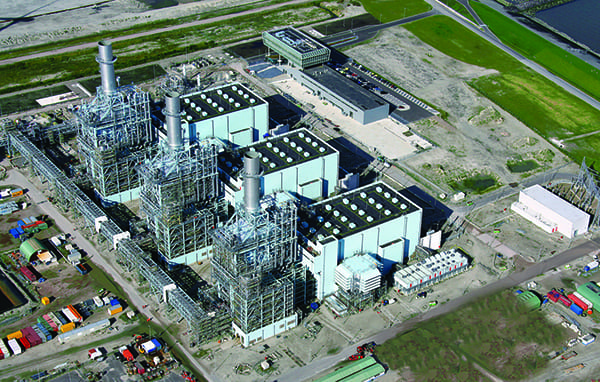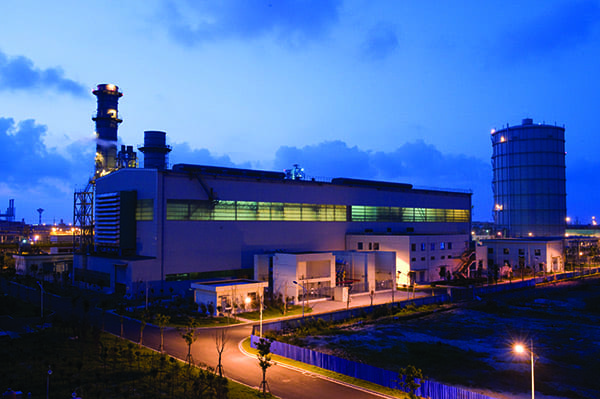High-Volume Hydrogen Gas Turbines Take Shape
In preparation for a large-scale power sector shift toward decarbonization, several major power equipment manufacturers are developing gas turbines that can operate on a high-hydrogen-volume fuel.
According to several experts, efforts by companies like Mitsubishi Hitachi Power Systems (MHPS), GE Power, Siemens Energy, and Ansaldo Energia to develop 100% hydrogen-fueled gas turbines have recently shifted into high gear, owing in part to new carbon reduction policies worldwide that have accelerated renewables capacity. The companies—which all manufacture large gas turbines but are jostling to sell them in a diminished market—are also actively competing for a concrete footing in future markets, including those that could thrive in a hydrogen economy.
Experts note hydrogen—the most abundant and lightest of elements—is odorless and nontoxic, and it has the highest energy content of common fuels by weight, which means it can be used as an energy carrier in a full range of applications, from power generation to transportation and industry. Though it is not found freely in nature and must be extracted (produced, or “reformed”) via a separate energy source (such as power, heat, or light), the hydrogen industry is today well-established in sectors that use it as a feedstock. Increasingly, however, hydrogen is being considered the missing link in the energy transition as key technologies to produce it using renewable electricity, such as proton exchange membrane electrolyzers and fuel cells, reach technical maturity and economies of scale.
[For an interactive graphic showing projects around the world that have been commissioned since 2000, are under construction, or are planned that use hydrogen to supply power to the grid with a gas turbine or fuel cell, see “THE BIG PICTURE: Hydrogen Power.”]
Gearing Up for a Hydrogen Society
MHPS, a joint venture between Japanese giants Mitsubishi Heavy Industries and Hitachi, has been especially vocal about efforts to align with Japan’s ambitions to become a “hydrogen society,” which were announced in the aftermath of the 2011 earthquake and tsunami that led to the Fukushima Daiichi nuclear plant meltdown. The government-industry collaboration comprises three phases: First it will extend its current fuel cell program to help reduce prices for hydrogen and fuel cells; then it envisions the large-scale introduction of hydrogen power generation and hydrogen supply infrastructure; and finally, it would establish a zero-carbon emission supply system throughout the manufacturing process.
At IHS Markit’s CERAWeek in Houston this March, MHPS rolled out a market case for increased hydrogen use in the power sector, saying it wants to make hydrogen-fired gas turbines a key facet of a “global CO2 -free hydrogen society using renewable energy by 2050.” As MHPS President and CEO Paul Browning told POWER, while natural gas will continue its significant role to address variability from renewables, the next phase of development “will involve storage of electricity using hydrogen.” Hydrogen’s production from renewables through electrolysis—which uses excess renewable power to split a water molecule—allows for the “renewable hydrogen” to be stored and used later in a combined cycle gas turbine (CCGT), he explained.
Since 1970, MHPS has fired 29 gas turbine units with hydrogen content ranging between 30% and 90%, tests that have spanned over 3.5 million operating hours. A key challenge the company grappled with was to reduce high NOx emissions associated with hydrogen combustion without compromising efficiency. Because hydrogen has a higher flame speed compared to natural gas, MHPS also sought to reduce the risk of combustion oscillation and “flashback” (backfire) in higher hydrogen mixes.
One solution was to develop a “diffusion combustor” based on the company’s dry low-NOx (DLN) technology that injects fuel to air. The combustor reduces NOx using steam or water injection, but it retains a relatively wide range of stable combustion, even if fuel properties fluctuate up to 90%. Fired at 30% hydrogen, the technology can handle an output equivalent of 700 MW (in combined cycle mode with a turbine inlet temperature of 1,600C) as well as reduce carbon emissions by about 10% compared to a conventional CCGT, it said.
 |
|
1. Vattenfall’s Magnum power plant in the Netherlands is shown here. Mitsubishi Hitachi Power Systems (MHPS) has verified that conversion to hydrogen-fired power generation is possible on these units. Courtesy: MHPS |
MHPS is currently piloting a project to convert one of three units at Vattenfall’s 1.3-GW Magnum combined cycle plant in the Netherlands (Figure 1) to renewable hydrogen by 2023. The project in Groningen, which entails modifying a 440-MW M701F gas turbine, will refine the combustion technology “to stay within the same NO x envelope as a natural gas power plant but do it burning 100% hydrogen,” without steam or water injection, Browning said. He said 100% will likely be achieved “in the next decade.”
Still, the project is key to MHPS’s vision to provide customers with gas turbines that could be upgraded to 100% hydrogen capability, he said. A hydrogen-fired gas turbine would likely need on-site electrolysis and storage for renewable hydrogen supply, and that would require a “very low cost of electricity,” he acknowledged. “What we’re waiting for is enough renewables penetration on electrical grids to justify [installation of on-site electrolysis] to make economic sense,” he said. “California’s getting there right now, though other places have a little ways to go.”
Asked how the technology will compete against advancements in battery storage, Browning said, “We think lithium-ion batteries will probably be the right choice if you want to store electricity for shorter periods of time.” The economics of hydrogen “are going to work no matter how long you store it,” he noted.
Breakthroughs at Siemens
MHPS will have to contend with competition from Siemens, which estimates it could unveil a 25-MW to 50-MW hydrogen-burning gas technology within two years. As Michael Welch, industry marketing manager at Siemens Industrial Turbomachinery told POWER at the Energy, Utility, Environment Conference in San Diego this February, hydrogen could certainly compete in a renewables-heavy future because relying on batteries alone would mean taking stock of degradation owing to cycling.
But despite millions of operating hours spent to improve hydrogen combustion by the petrochemical industry, hydrogen power currently suffers major drawbacks. Welch noted that at least 60% of hydrogen gas turbines under development by an assortment of manufacturers use DLN combustor technology, which is “a challenge because of the way gas turbines have evolved over the years.” Power conversion also needs additional equipment and water.
As significantly, today, running electrolysis to produce 50 MW for one hour at a CCGT running at 50% efficiency could require 175 MW of renewable power and 3,400 kilograms (more than 14,000 gallons) of hydrogen, he said. “So, the affordability part of the equation could be an issue,” which is why hydrogen power could prove more economical as short-term (three or four hours a day) renewable support in places such as Europe, he added.
However, Siemens, which is tackling similar technical challenges concerning NOx emissions and flashback risk control, appears to have made some gains in determining the components and materials needed for high-temperature hydrogen combustion. It has also incorporated additive manufacturing for burners.
“Now, one single part can be integrated into the structure with no welds. We’ve reduced the weight and the manufacturing time by more than three-quarters, and it has enabled us to get the profiles that we want,” Welch said. “This has enabled us to basically do testing that we couldn’t before and change the science as we go along.” All these improvements allowed the team to run a turbine prototype in Germany on 100% hydrogen in mid-February, he said.
While the breakthrough is notable, Siemens’ test families of hydrogen turbines from 4 MW to 560 MW “don’t have very good dry, low-emissions technology capabilities yet, but the conventional capabilities are quite high,” said Welch.
Asked about an industrywide outlook for commercialization of hydrogen power, Welch said the initial focus will likely be on units smaller than 70 MW. Decarbonization policy pushes with a hydrogen focus could also boost technology development. Along with Japan, members of EUTurbines—an association of the entire gas and steam turbine sector in the European Union (EU)—in January committed to provide gas turbines that can handle 20% hydrogen by 2020, and 100% hydrogen by 2030.
GE, Ansaldo Build on Past Gains
Italian engineering firm Ansaldo Energia, which is part of that commitment, also appears to be making gains on its hydrogen gas technology. The company said combustor tests have proven 100% hydrogen is possible. It told POWER that “being able to burn hydrogen alone or in combination with natural gases, and to do it safely and efficiently, could … make all the difference” to a future where existing gas-fired plants are bound to play a role as “guarantors of grid reliability.”
The company already offers fuel-flexible advanced gas turbine combustion systems. “For example, the latest GT26 F-Class and GT36 H-Class gas turbine equipment leverages the Sequential Environmental (SEV) combustion system platform and has been designed with an unrivaled ability to burn the largest range of [natural gas and hydrogen] blended fuel mixture for new power plants being offered today,” it said. It also offers a hydrogen fuel flexibility retrofit solution for the currently installed base of F-class gas turbines.
 |
|
2. A steel mill operated by the Luojing Baosteel Group Co. Ltd. in Shanghai, China, is using electricity from this power plant burning hydrogen-rich steel mill gas as a fuel. Courtesy: GE Power. |
General Electric (GE), meanwhile, already offers combustion systems for both aero-derivative and heavy-duty gas turbines (Figure 2) that are capable of operating with increased levels of hydrogen. Aero-derivative gas turbines can be configured with a single annular combustor (SAC), which can operate on a variety of fuels, including process fuels and fuel blends with hydrogen, and GE says there are more than 2,500 gas turbines configured with this combustion system.
It has also developed two combustor configurations for heavy-duty turbines for higher hydrogen content: the single-nozzle, which is available on B- and E-class turbines, and the multi-nozzle quiet combustor for E- and F-class turbines. These have been installed on 1,700 turbines.
Notably, with funding from the U.S. Department of Energy, GE has also developed a low-NOx hydrogen combustion system based on the “operating principle of small-scale jet-in-crossflow mixing of the fuel and air streams,” it said. The advanced premixing capability is now an element in GE’s DLN 2.6e combustion system, which is available on the 9HA gas turbine.
GE also boasts several projects that use high hydrogen content. One is at the Daesan refinery in South Korea, which has operated on a 70% hydrogen fuel for 20 years using a 6B.03 gas turbine. ENEL’s 2010-inaugurated Fusina plant in Italy used an 11.4-MW GE-10 gas turbine to operate on fuel that was more than 97.5% hydrogen by volume.
However, development of hydrogen combustion technology is still ongoing at GE, which considers hydrogen a potential future fuel, as Jeffrey Goldmeer, director of GE Power’s Gas Turbine Combustion & Fuels Solutions arm told POWER on May 2.
[A full interview with Dr. Goldmeer is here: “The POWER Interview: GE Unleashing a Hydrogen Gas Power Future.“]
“GE gas turbines have been operating on hydrogen and similar low BTU fuels for more than 30 years. During this period, GE has installed over 70 gas turbines that have accumulated more than 4.5 million operating hours on these fuels,” he said. Now, the company is focusing its efforts on the use of additive manufacturing in developing next-gen combustion systems. “These efforts have resulted in approximately 50% [hydrogen] capability for the DLN 2.6e combustion system, which is excellent news for our customers,” Goldmeer said.
—Sonal Patel is a POWER associate editor.